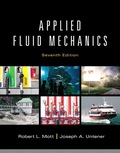
Concept explainers
Define shear stress as it applies to a moving fluid.
Shear stress as it applies to a moving fluid.
Explanation of Solution
Shear pressure is most ordinarily connected to solids. Shear powers acting extraneously to a surface of a strong body cause disfigurement. As opposed to solids that can oppose miss happening, fluids do not have this capacity, and stream under the activity of the power. At the point when the liquid is in movement, shear stresses are created because of the particles in the liquid moving in respect to each other.
For a liquid streaming in a pipe, liquid speed will be zero at the pipe divider. Speed will increase while moving towards the focal point of the pipe. Shear powers are regularly present on the grounds that adjoining layers of the liquid move with various speeds contrast with one another.
By thinking about the speed of this relative movement, shear rate,
Where,
Want to see more full solutions like this?
Chapter 2 Solutions
Applied Fluid Mechanics
Additional Engineering Textbook Solutions
Problem Solving with C++ (10th Edition)
Thinking Like an Engineer: An Active Learning Approach (4th Edition)
Degarmo's Materials And Processes In Manufacturing
Mechanics of Materials (10th Edition)
Java: An Introduction to Problem Solving and Programming (8th Edition)
Starting Out with Python (4th Edition)
- In mechanical fluidarrow_forwardHow can the equivalent point forces of fluids be found?arrow_forwardFor flow over a plate, the variation of velocity with vertical distance y from the plate is given as u(y) = ay relation for the wall shear stress in terms of a, b, and u. by where a and b are constants. What is the correct –arrow_forward
- Define longitudinal and hoop stresses in a thin walled in thin walled pressure vessels. Support your answer with neat sketches.arrow_forward2.27 Fluids of viscosities µ1 = 0.1 N s/m2 and 42 = 0.15 N s/m2 are contained between two plates (each plate is 1 m? in area). The thicknesses are h1 = 0.5 mm and h2 = 0.3 mm, respectively. And the upper plate moves at a velocity of 1.5 m/s. Determine the force required to move the upper plate and the fluid velocity at the interface between the two fluids. F, V h2 H2 h1 P2.27 Hint: Both Velocity and Shear stress are continuous at the fluid-fluid interface.arrow_forwardi need the answer quicklyarrow_forward
- In an inclined open channel, velocity distribution of the flow is given by the equation, 2. a thin film of liquid is flowing down. The 1 (h² – y²)pgsinO u = Where h = depth of flow, e = angle of inclination of the channel to the horizontal, u = velocity at a depth h below the free surface, p = density of liquid, µ = dynamic viscosity of the fluid. Calculate the shear stress: (a) at the bottom of the channel (b) at mid-depth (c) at the free surface. The coordinate y is measured from the free surface along its normalarrow_forward2- Velocity distribution of fluid over a flat plate is given by: U = % y - y in which (u) velocity in m/s at a distance (y) m above the plate. Determine the shear stress (t) at y 0.15 m. The dynamic viscosity of the fluid is 8.6 poise.arrow_forwardDescribe a Newtonian fluidarrow_forward
- What is press vessels?Application of plane stresses in pressure vessels. Please explain brieflyarrow_forwardQ2-2 [5 Points]:A fluid has an absolute viscosity of 0.048 Pa-s and a specific gravity of 0.913. For flow of such a fluid over a solid flat surface, the velocity at a point 50 mm away from the surface is 1.18 m/s. Calculate the shear stresses at the solid boundary (N/m) 1.16 1.13 O 0.2 O 1.18 O 2.06 2.31 2.1 1.5arrow_forwardASAParrow_forward
 Elements Of ElectromagneticsMechanical EngineeringISBN:9780190698614Author:Sadiku, Matthew N. O.Publisher:Oxford University Press
Elements Of ElectromagneticsMechanical EngineeringISBN:9780190698614Author:Sadiku, Matthew N. O.Publisher:Oxford University Press Mechanics of Materials (10th Edition)Mechanical EngineeringISBN:9780134319650Author:Russell C. HibbelerPublisher:PEARSON
Mechanics of Materials (10th Edition)Mechanical EngineeringISBN:9780134319650Author:Russell C. HibbelerPublisher:PEARSON Thermodynamics: An Engineering ApproachMechanical EngineeringISBN:9781259822674Author:Yunus A. Cengel Dr., Michael A. BolesPublisher:McGraw-Hill Education
Thermodynamics: An Engineering ApproachMechanical EngineeringISBN:9781259822674Author:Yunus A. Cengel Dr., Michael A. BolesPublisher:McGraw-Hill Education Control Systems EngineeringMechanical EngineeringISBN:9781118170519Author:Norman S. NisePublisher:WILEY
Control Systems EngineeringMechanical EngineeringISBN:9781118170519Author:Norman S. NisePublisher:WILEY Mechanics of Materials (MindTap Course List)Mechanical EngineeringISBN:9781337093347Author:Barry J. Goodno, James M. GerePublisher:Cengage Learning
Mechanics of Materials (MindTap Course List)Mechanical EngineeringISBN:9781337093347Author:Barry J. Goodno, James M. GerePublisher:Cengage Learning Engineering Mechanics: StaticsMechanical EngineeringISBN:9781118807330Author:James L. Meriam, L. G. Kraige, J. N. BoltonPublisher:WILEY
Engineering Mechanics: StaticsMechanical EngineeringISBN:9781118807330Author:James L. Meriam, L. G. Kraige, J. N. BoltonPublisher:WILEY





